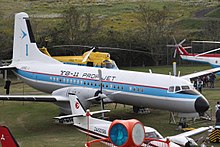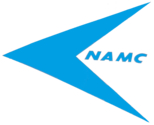Nihon Kōkūki Seizō
| Nihon Kōkūki Seizō ( Japanese 日本 航空 機 製造 )
|
|
|---|---|
| legal form | Kabushiki-gaisha (joint stock company) |
| founding | June 1, 1959 |
| resolution | March 23, 1983 |
| Seat | N / A |
| management | Shōda Taizō |
| Number of employees | 125 |
| Branch | Aircraft construction |
| Status: June 1, 1959 | |
Nihon Kokuki Seizo ( Jap. 日本航空機製造株式会社 , - kabushiki-gaisha ., Eng Nihon Aircraft Manufacturing Corporation , in short NAMC ) was a Japanese aircraft manufacturer whose only product is the first fully developed in Japan passenger jet , the NAMC YS-11 , was .
history
prehistory
After the Japanese Empire surrendered in September 1945 and accepted the conditions of the Potsdam Declaration , the Allied- occupied Japan was forbidden to be active in aircraft construction or in other areas of aviation in order to prevent its rearmament. This ban was not lifted until the peace treaty of San Francisco came into force in April 1952, after the occupation authorities had approved the re-establishment of Japan Airlines a year earlier . As a result, a large number of the airlines founded in 1952, such as All Nippon Airways or Tōa Domestic Airlines, expressed their desire for a Japanese passenger aircraft.
In May 1956, due to the advanced age of the Nakajima L2D aircraft still in service at the time , the Ministry of Economic Affairs published a “Concept for the Development of a Domestic Narrow- Body Airliner ” ( 中型 輸送 機 の 国産 化 計画 構想Chūgata as part of the first of the Japanese five-year plans) -yusō-ki no kokusan-ka keikaku-kōsō ). At the same time, the Ministry of Transport was also examining the development of a passenger aircraft, whereupon it was decided by cabinet decision that the Ministry of Transport was responsible for acquiring the airworthiness certificate and that the Ministry of Economic Affairs should control production. Along with this decision, Shin-Meiwa Kōgyō was the first company to investigate a concrete implementation of this project. In view of these developments, the 1957 budget made an amount of 35 million yen available for the development of such an aircraft.
In May 1957, at the urging of the Ministry of Economic Affairs and the Aviation Industry Association , the University of Tokyo founded the University Foundation “Research Association for the Development of a Commercial Airplane ” ( 輸送 機 設計 研究 協会Yusō-ki sekkei kenkyū-kyōkai ). Numerous companies such as Mitsubishi Heavy Industries ( MHI ), Kawasaki Heavy Industries ( KHI ), Fuji Heavy Industries ( FHI ), Shin-Meiwa Kōgyō, Nippon Hikōki and Shōwa Hikōki Kōgyō took part in this to prevent the formation of a monopoly . They agreed on the project name "YS-11" and presented a demonstration model in December 1958 .
founding

On June 1, 1959, the foundation was dissolved and the public limited company Nihon Kōkūki Seizō was founded. The chair was held by the then Vice-Head of MHI, Shōda Taizō ( 荘 田 泰 蔵 ); the head of the technical department was Tōjō Teruo ( 東 條 輝 ehemaligen ), the second son of the former Prime Minister Tōjō Hideki and also an MHI employee. Very experienced aircraft engineers such as Jirō Horikoshi or Doi Takeo declined to participate in the project after they had already worked on the basic concept at the foundation. The company's starting capital was ¥ 500 million, of which ¥ 300 million was provided by the state and the remaining ¥ 200 million by the companies involved.
On August 30, 1962, a prototype of the YS-11 took off on its maiden flight, whereupon All Nippon Airways became the first airline to order 20 copies two months later. However, difficulties and delays in obtaining the type certification occurred, which is why the deliveries to the airlines had to be postponed several times. In March 1965, the first production aircraft was finally put into service and the development phase was completed with the acquisition of the type certification by the US aviation authority in September of that year.
The next project NAMC presented in 1966 was the “CX” concept, which was intended to replace the aging Curtiss C-46 aircraft used by the Air Self-Defense Forces . The parliamentary opposition parties at the time, such as the Socialist Party of Japan, criticized such an approach, however, since it was agreed when NAMC was founded that the company would limit itself to the production of civilian airliners. Thereupon five companies split off from NAMC and developed under the leadership of KHI the Kawasaki C-1 , which was put into service in 1973.
resolution
Since the state was the majority shareholder of NAMC and thus closely linked to the company, many higher positions were filled by former government officials ( Amakudari ), which is why the administrative structure gradually became more confusing. The sales of the YS-11 also remained below expectations and the project was consequently plagued by inefficiency. The company was already in the red in 1966 and lost ¥ 8 billion in the 1969 financial years and ¥ 14.5 billion in 1970. In April 1971, an investigative committee of the Aviation Industry Association presented a reorganization plan that included the cessation of production of the YS-11. To overcome the crisis, NAMC also planned the development of a jet-powered version of the YS-11 with the designation "YS-11J", a version with STOL properties "YS-11S", an extended and jet-powered version "YS-33" for 106 to 149 passengers and the “YX” wide-body aircraft for 150 to 250 passengers. However, due to financial difficulties, none of these concepts were implemented.
In May 1973 the production of the YS-11 was finally stopped with the completion of the 182nd copy, which was delivered to the Japanese Navy in February 1974 . From this point on, NAMC's field of activity was limited to the maintenance and manufacture of spare parts for the YS-11. The drafts for new aircraft made by NAMC took over the consortium founded by MHI, KHI and FHI "Research Association for the Development of a Japanese Civil Airliner " ( 日本 民間 輸送 機 開 発 協会Nihon minkan-yusō-ki kaihatsu-kyōkai ), which together with the US - American aircraft manufacturer Boeing initially designed the Boeing 7J7 and later the Boeing 767 .
A cabinet decision of December 28, 1981 determined that NAMC should be fully privatized during 1982. Consequently, MHI took over the company in September 1982; the budget deficit at that time was ¥ 36 billion. On March 23, 1983, NAMC was finally dissolved by a cabinet decision and maintenance of the YS-11 was taken over by MHI.
Participating companies
| Surname | Production share |
|---|---|
| Mitsubishi Heavy Industries | 54.2% |
| Kawasaki Heavy Industries | 25.3% |
| Fuji Heavy Industries | 10.3% |
| Nippon Kōkūki | 4.9% |
| Shin-Meiwa Kōgyō | 4.7% |
| Shōwa Hikōki Kōgyō | 0.5% |
| Sumitomo Seimitsu Kōgyō | 0.1% |
In addition, Sumitomo Kinzoku Kōgyō , Shimadzu , NEC Corporation , Toshiba , Mitsubishi Electric and Tōkyō Kōkū Keiki acted as suppliers .

